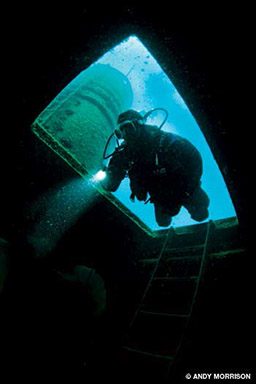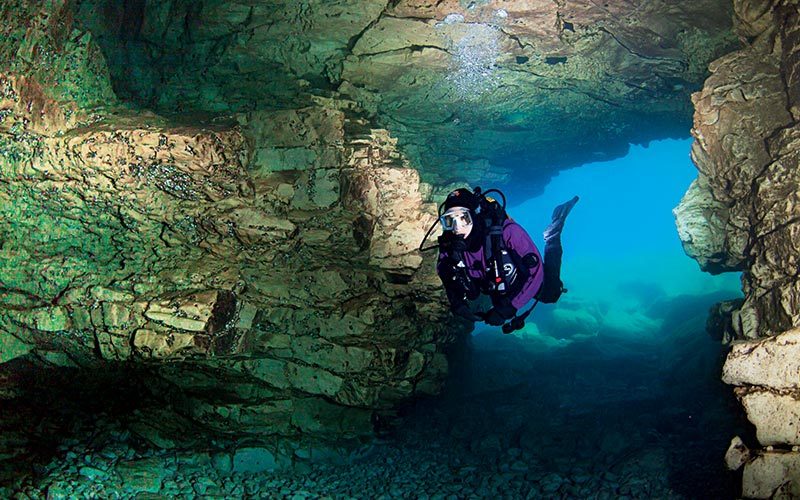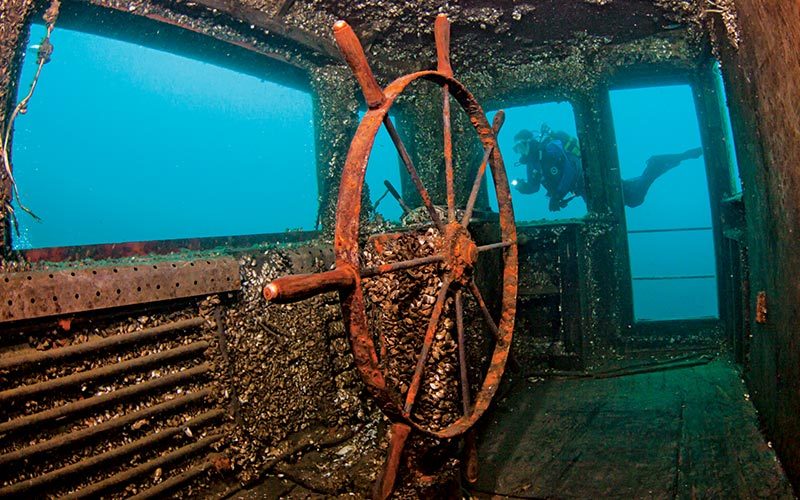I had heard about what to expect when gearing up and splashing in off the coast of Canada’s Tobermory: I was in for some spectacular diving, but I’d better be ready for cold. “I’m a Great Lakes diver,” I thought. “Cold is what I do.” But even divers who usually shy away from chilly water will find it hard to resist the area’s well-preserved wooden vessels replete with an impressive array of wheels, bowsprits and anchors.

The sight of the Arabia, which has spent more than 125 years underwater, is enough to ease a bout of the shivers. A signature shipwreck in the Fathom Five National Marine Park of Canada, the Arabia is a three-masted wooden barque that sank in heavy seas in 1884. I descended down a line into Lake Huron onto the Arabia‘s fully intact bow and a stunning view of its bowsprit. Local captain Larry Graham of Divers Den lists the Arabia among Tobermory’s “crown jewels,” and it’s easy to see why. This ship has everything. After spending some time at the bowsprit, I slowly glide over broken decking toward the ship’s great windlass, which is flanked by two impressive anchors. Deadeyes peek up from the railing as I travel sternward, and there in the muck off the starboard side is the ship’s wheel, still standing upright. Its depth (about 120 feet) and the cold temperature mean the Arabia is best considered an advanced dive.
Tobermory is located at the northern tip of the Bruce Peninsula, a sliver of land cutting into Lake Huron and defining Georgian Bay. Among Tobermory’s best attributes is the variety of dive sites available. The topography of the lakebed features areas of sharp decline, and diveable wrecks exist in water from as shallow as 10 feet to well beyond recreational depths. The sharp drops and rises are actually responsible for many of the wrecks: Ships cruising along in deep water would hit shoals that seemed to arise out of nowhere. The multiple levels under the waves can be better understood by taking in the amazing sights above the water. Large and small islands — dozens of them — dot the surface. Among them is the much-visited Flowerpot Island, which gets its name from its unusual rock pillars, products of weather and time.
“Something we have that’s unique among Great Lakes destinations is that there is always somewhere to dive because of all the islands that protect the sites,” Graham said. For me the chain of small, uninhabited islands brought back memories of diving the Galapagos, where fish, fowl and other fauna were our only company. Although there were no whale sharks to greet us beneath the surface in Tobermory, the tree-covered islands and soaring birds — including a bald eagle — were reminiscent of being out on the open sea surrounded by nature.
One of the area’s dive highlights, the City of Cleveland, is just outside the marine park. This 255-foot-long wreck lies in only 30 feet of water and has an abundance of interesting features. After a giant stride into the lake, I was greeted by large boilers and lengths of wooden decking. But the highlight of the dive was the propeller, which stands tall in the clear, bright water. Hovering in such shallow depths with a full tank of air, I could have spent hours on the ship, poking around the timber planks and the engine room, but the knowledge of a long boat ride home brought me back to the surface. Despite the two-hour ride to the site, the City of Cleveland should not be missed.

Each new site I visit in Tobermory brings a new favorite shipwreck. After three awesome days of diving, I jumped in on the fourth day above the Forest City. A three-masted wooden schooner later transformed into a steamer, the ship sank in June 1904 in a dense fog after striking nearby (and aptly named) Bears Rump Island. I’ve often thought descents down mooring lines in the lakes are like elevator rides: straight down. But on the Forest City, it was as if I was taking an escalator down the top of the broken wreck, gradually following the island’s rocks down onto the ship at 60 feet and then down the broken decking to the stern, which sits at 150 feet. I chose to limit my dive to 120 feet, but I don’t think I missed anything by not going all the way to the bottom. With excellent 50-plus-foot visibility, I could easily observe the ship’s stern railings, the wreck’s signature feature.
Another similarly situated ship is the James C. King, a barge sunk while under tow in November 1901. The bow rests in about 90 feet of water, and carved Roman numerals, the King‘s draft marks, can be seen along the hull. Slowly returning up the decking of this ship to the crushed stern at 25 feet, it’s as if I’m following an underwater boardwalk that leads me to the surface. Off to the side of the main wreckage is a wooden rudder, and a bit further beyond it is more of the broken boat, its boards fashioned together with steel pegs.

In my time underwater off Tobermory’s coast, I realized I did not have to share the wrecks with zebra mussels, an invasive species that has all but infested the Great Lakes. Although clumps were present, for the most part the ship’s details were easily seen. Those draft marks on the King would have been impossible to discern if the zebra mussels had taken over.
Tobermory also has some geological sites that offer alternatives to shipwreck dives. Dunk’s Point, North Otter Wall and The Caves (also known as The Grotto) are among the more unusual spots. At The Caves I followed clean, white rocks and boulders along the shoreline to an underwater swim-through, which opened up into a sheltered grotto. Be careful when ascending from the dark water here; you’ll likely encounter swimmers, some of whom may be ready to cool off with a jump down into the chilly water.
No trip to Tobermory would be complete without a visit outside the marine park to the Niagara II. Intentionally sunk in 1999 in 100 feet of water by the Tobermory Maritime Association, this sandsucker helps ease some of the pressure on the area’s older wrecks by giving divers a place to play. The locals certainly have made it interesting; in addition to the easily penetrable hull and intact railings, a few features have been added just for fun, including a piano (which was pretty smashed up when I saw it) and a Canadian flag that “flies” from the stern. My favorite part of this 182-foot ship is its pristine wheelhouse, mostly because of the story that accompanies it. Graham, president of the maritime association that made the wreck possible, noticed that there wasn’t a wheel in the ship, so he built one. “A ship without a wheel is like a person without a soul,” he said. “How do you connect with a ship if it doesn’t have a wheel?”

How To Dive It
Fathom Five National Marine Park of Canada is a 45-square-mile area consisting of 20 islands and 22 shipwrecks. Several other dive sites exist outside the park. Divers must register in person at the Parks Canada visitor center in Tobermory before diving within the park boundaries. Nominal fees support a mooring buoy system, research projects, marine emergency services and the Tobermory hyperbaric chamber, which is located in town. Three companies — Divers Den, G & S Watersports and Tobermory Aquasports — offer charters, air fills and other dive services out of Little Tub Harbour in Tobermory. For more information, visit www.pc.gc.ca/fathomfive or call +1-519-596-2233.

CONDITIONS: In general, the dive season runs from May through October; depending on the season, temperatures range from 40°F at depth to nearly 70°F on the surface. Wind and weather conditions can impact access, but because of the many islands sheltering the dive sites, it’s rare to not be able to dive.
GETTING THERE: Tobermory is located at the tip of Ontario’s Bruce Peninsula along Canada’s Highway 6. Americans, don’t forget your passports.
ON THE SURFACE: In addition to offering a variety of options for shore diving, Tobermory radiates a fun small-town vibe. Several motels and places to camp are available, but book early. Tobermory is a popular vacation destination, and rooms fill quickly. Other popular activities include hiking, biking, kayaking and glass-bottomed boat rides. You might get lucky with wildlife sightings, too. We saw a beaver swimming in the harbor while waiting for evening fireworks on Canada Day and a porcupine waddling down the road as we traveled toward town. The Fish & Chip Place serves an awesome signature dish, and try the poutine, a traditional Canadian dish consisting of fries covered in gravy and cheese curds. Also, don’t miss the opportunity to devour a pastry at Beavertails, which creates memorable desserts by adding toppings to fried dough.

© Alert Diver — Q1 Winter 2013